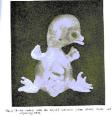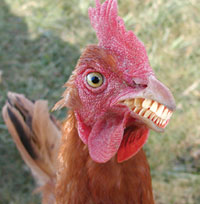And the tale told by John Fallon and Matthew Harris, seems almost as strange as Kipling's famous fictions. The strange part came when the scientists got a chicken to grow alligator teeth.
Confused? It's all explained in the journal Current Biology. Just look up the article titled "The Development of Archosaurian First-Generation Teeth in a Chicken Mutant." Alligator teeth in a chicken is not as bizarre as it might at first seem. And that of course is because alligators are among the closest living relatives to modern birds.
Fallon, a professor of anatomy, and Harris, one of his graduate students, took advantage of a surprising and accidental discovery to turn back the evolutionary clock, and show through the science of genetics that chickens retain the gene for the long-lost ability to make teeth resembling those of their ancient ancestors.
Three years ago, Harris was studying connections between feathers and scales. In one of the birds he was using, the beak had fallen off. Looking closely at the part of the bird's mouth that had been hidden by the beak, Harris saw small bumps.
Curious about the story behind the bumps - they looked vaguely tooth-like and were conical in shape - Fallon and Harris embarked on a three-year quest to answer the toothy riddle posed by the chicken without a beak.
 The chickens used by Fallon and Harris are mutant birds, a research strain known as talpid2 that never hatch; biologists study the embryos. Through their genetic sleuthing, Fallon and Harris found the growth of teeth in both alligators and chickens to be regulated by the same gene.
The chickens used by Fallon and Harris are mutant birds, a research strain known as talpid2 that never hatch; biologists study the embryos. Through their genetic sleuthing, Fallon and Harris found the growth of teeth in both alligators and chickens to be regulated by the same gene.And by signaling the gene to do its job, the chicken embryos grew early-stage teeth similar to the same conical-shaped teeth present in alligator embryos.
"It makes sense. They're cousins to one another," said Fallon of chickens and alligators. So why don't chickens and other birds still grow teeth?
Tooth formation in alligators and chickens, Fallon said, is the result of signaling between two tissues in the mandible, the epithelium and the mesenchyme. The hypothesis put forth by the researchers is that in distant time the two tissues separated so the birds don't grow teeth. In the mutant chickens, the tissues had grown together again, thus the budding teeth noticed by Harris. Still, modern-day birds retained the genetic mechanism necessary to make teeth.
Sean Carroll, a UW-Madison developmental biologist not involved with the work, said it's common for a species to lose traits - such as the chicken's teeth - over time.
"Loss happens a lot," Carroll said. "Hey, we lost our tails!"

further up the evolutionary ladder...

No comments:
Post a Comment